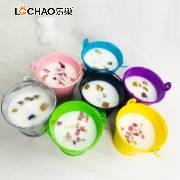The main reasons why jelly wax is more expensive than soybean wax are raw material cost, production process, market positioning and functional differences. The following is a detailed analysis:
1. Higher raw material cost
- The base material of jelly wax is complex:
Jelly wax is usually made of a mixture of paraffin, mineral oil, polymers (such as polyethylene), etc. Some high-end products will add soybean wax to improve environmental protection. The purification and modification costs of these chemical raw materials are high, especially for jelly wax with strict requirements on transparency and texture.
- Comparison: Soybean wax has a single raw material (hydrogenated soybean oil), and its price is affected by fluctuations in the agricultural product market, but it is more stable and cheap overall.
- Additive ingredients:
Jelly wax needs to add thickeners and transparent agents to maintain the "jelly"-like gelatinous texture, while soybean wax does not require these additional ingredients.
2. More complex production process
- High transparency and stability requirements:
Jelly wax needs to be melted at high temperature and then slowly cooled to avoid bubbles or turbidity, and strict temperature control is required; while soybean wax has a simple process and only needs to be melted and poured into the mold.
- Decorative processing:
Jelly wax often needs to be embedded with dried flowers, shells and other decorations, which requires layered pouring or manual adjustment, which is time-consuming and labor-intensive; soybean wax is usually directly formed and has less complex decoration.
3. Market positioning differences
- Jelly wax focuses on "appearance economy":
Its transparent texture and artistic design (such as ocean themes) cater to the high-end gift and home decoration market, and there is a large premium space.
- Soybean wax emphasizes "natural and environmental protection":
The audience is more concerned about practicality (such as aromatherapy, sleep aid), and the price tends to be close to the people.
4. Functional cost
- Combustion performance optimization:
Pure jelly wax is easy to soften and deform, and stearic acid needs to be added to improve the combustion performance, while soybean wax has a moderate natural melting point and does not require additional adjustment.
- Fragrance compatibility:
Jelly wax has poor dispersion of essential oils, and requires special formulas to avoid uneven fragrance, which increases R&D costs.
5. Influence of supply and demand
- Limited production capacity of niche products:
There are few jelly wax manufacturers, and most of them are small-batch customization, with low scale effect; the soybean wax industry chain is mature, with sufficient supply and obvious cost dilution.
Exceptions
If a large amount of cheap paraffin wax is added to jelly wax, or soybean wax uses organic certified raw materials, the price difference may be narrowed. But overall, the "high appearance + process threshold" of jelly wax determines its higher premium.





